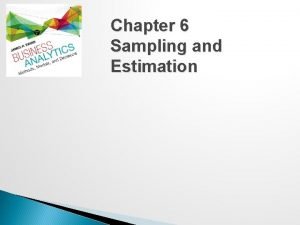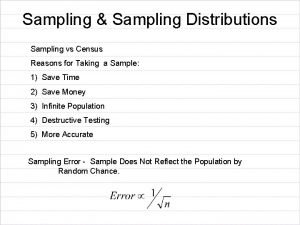The Importance of Understanding Sampling In Research with















- Slides: 15

The Importance of Understanding Sampling In Research with a Focus on Business and Human Resource Development in Thailand By Arthur Dryver, Wasita Boonsathorn, and Kanogporn Narktabtee National Institute of Development Administration

Outline n What is sampling? n A representative sample n Various sampling designs n The role of sampling in quantitative research n Example of the dangers of convenience sampling in relations to quantitative research n With a focus on Business and Human Resource Development in Thailand n Concluding remarks

What is sampling? n A sample in the very general sense is a set of units observed from the all possible units. n The desire in taking a sample is to learn about a larger group, the population. n The sampling frame is the set of units the researcher will take the sample from. n Ideally the sampling frame is the same as the population of interest. n In reality this is often not possible. n The sampling design is the methodology in which the data is collected. n The sampling design can aid in obtaining a representative sample of the population. That is a sample that’s attributes are similar to the population of interest.

Sampling n More important than sample size is how the sample was taken. Example: n Imagine if a survey of the 10, 000 people and their attitude on the sky train and how often they take the sky train was taken from people as they were entering or exiting from different locations of the sky train. n Imagine the same survey taken of 10, 000 people living in Bang Na. n Imagine if the same survey taken of 2, 000 people from various randomly chosen locations throughout Bangkok. n From the latter examples it is clear that how the data is collected will have a great impact on the findings n Which survey results would you trust to represent people living in Bangkok.

Various sampling designs - Simple Random Sampling (SRS) n A simple random sample is a sample in which all units in the sampling frame have an equal probability of selection. n Many statistical tests have certain assumptions that they rely on and these assumptions are often met when a simple random sample is taken. n If the researcher wanted to collect a simple random sample of people in Bangkok, the researcher would need a list of all people in Bangkok. n n Where would this list come from? A telephone list, is only a list of all people in Bangkok with a telephone.

Various sampling designs - Stratified Sampling n The population is separated in groups or strata and from within each strata a SRS is taken. n Again where would this list come from for each strata to perform a SRS within each strata?

Various sampling designs Convenience Sampling n A sample collected by what is convenient n n For example, collecting surveys from a shopping mall, yielding a lot of data at a low price. Note: statistical tests are inappropriate when performed on a convenience sample

The role of sampling in quantitative research n Statistics is at the heart of quantitative research and sampling is a very important part of statistics. n There is an old saying “Garbage in garbage out (G. I. G. O. ). ” n For understanding G. I. G. O. in reference to statistics and sampling the reader can think of how a “garbage” sample would yield “garbage” statistical results.

The role of sampling in quantitative research n For many research projects collecting data takes a large portion of the overall time of the project. After collecting and entering the data using statistical software packages, such as SPSS or Minitab, the statistics can be calculated within minutes. n A very important fact though is that getting an answer and getting the right answer are not the same thing. n n Most evident when thinking of exams. n Think about G. I. G. O. before deciding how to collect the data.

Example n The authors have created a fictitious population consisting of 6 companies with large, medium, and small market capitals and varying annual revenue. n The example research question is to estimate the average annual revenue of all companies in the population. n The population mean annual revenue, μ, equals 5, 283, 333 for this example.

Example (continued) SRS of size 3

Example (continued) SRS of size 3 excluding large Market Cap Companies A possible example of a convenience sample

Example (continued) Stratified sample of size 3, Strata is Market Cap (s. , m. , l. ) With a different sampling design a different formula for estimating the population mean is needed.

Example (continued) Comparison of the sampling strategies • SRS is unbiased but has a large standard deviation. • Stratified is unbiased with a much smaller standard deviation. • SRS Excluding large market cap. is very biased, more than 50% and has the smallest standard deviation, adding to how misleading the results are.

Concluding Remarks n Before collecting data think G. I. G. O. n Quality over quantity n Statistical tests – p-values may often be performed/calculated using convenience samples but they truly have no meaning when calculated on a convenience sample n Finally, the researchers note that much is easier said than done. That is, to take a proper sample is much easier said than done.
 Sampling method in research
Sampling method in research Objective of sampling
Objective of sampling Multi-stage sampling example
Multi-stage sampling example Yuli fajar susetyo
Yuli fajar susetyo Stratified sampling vs cluster sampling
Stratified sampling vs cluster sampling Theoretical sampling
Theoretical sampling Natural sampling vs flat top sampling
Natural sampling vs flat top sampling Sample objectives in quantitative research
Sample objectives in quantitative research Random sampling method in quantitative research
Random sampling method in quantitative research Qualitative sampling technique
Qualitative sampling technique Sample frame
Sample frame Philosophical assumption
Philosophical assumption Research sampling plan
Research sampling plan Purposive sampling
Purposive sampling Sampling techniques in qualitative research
Sampling techniques in qualitative research What is grounded theory in simple terms
What is grounded theory in simple terms



























